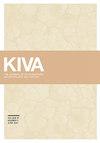The Bonito Paleochannel in Chaco Canyon, New Mexico: Recent Research and Implications for Causality and Effects
IF 0.4
0 ARCHAEOLOGY
Kiva-Journal of Southwestern Anthropology and History
Pub Date : 2023-10-04
DOI:10.1080/00231940.2023.2258322
引用次数: 1
Abstract
AbstractDuring the late eleventh century AD, a episode of erosion in Chaco Canyon, New Mexico, threatened to destroy portions of the Pueblo Bonito great house and possibly other large buildings. Known as the Bonito Paleochannel, this large arroyo meant the loss of significant amounts of surface water from valley-wide flooding originating in upstream and tributary sources. We believe that erosion was probably the result of an increasing size and frequency of floods. There is no compelling evidence that agriculture was affected by the paleochannel but we hypothesize that great house construction became extremely difficult. Consequently, the impact of the Bonito Paleochannel cycle may have been felt most in the political economy.A fines del siglo XI d. C., un episodio de erosión en el Cañón del Chaco, Nuevo México, amenazó con destruir partes de la gran casa de Pueblo Bonito y posiblemente otros edificios grandes. Conocido como el Paleocanal Bonito, este gran arroyo significó la pérdida de cantidades significativas de agua superficial debido a las inundaciones en todo el valle que se originaron en las fuentes río arriba y tributarias. Creemos que la erosión fue probablemente el resultado de un aumento en el tamaño y la frecuencia de las inundaciones. No hay evidencia convincente de que la agricultura se haya visto afectada por el paleocanal, pero planteamos la hipótesis de que la construcción de grandes casas se volvió extremadamente difícil. En consecuencia, el impacto del ciclo Bonito Paleochannel puede haberse sentido más en la economía política.KEYWORDS: Chaco CanyonBonito phasegreat housesBonito Palecochannelarroyo cyclepluvial periodmegadroughtpolitical economy AcknowledgementsField investigations and laboratory analyses were conducted under permits from Chaco Culture National Historical Park, United States National Park Service with funding from the National Science Foundation (BCS 1523224). David W. Love has provided critical geological insight throughout our research program and we have included some of his own original research in our Supplemental Material, but he is in no way responsible for any errors or misunderstandings in this article. Our deepest appreciation to Dabney Ford, Roger Moore and Wendy Bustard, as well as the many students who participated in the fieldwork. The authors are especially grateful to Gary Huckleberry and two anonymous reviewers for exceptionally close readings of the original manuscript and providing important insights and corrections.Disclosure StatementNo potential conflict of interest was reported by the author(s).University of New Mexico People’s Land and Territory AcknowledgementFounded in 1889, the University of New Mexico sits on the traditional lands of the Pueblo of Sandia. Since time immemorial, the original peoples of New Mexico – Pueblo, Navajo and Apache – have deep connections to the land and have made significant contributions to the broader community statewide. We honor the land throughout the generations and acknowledge our committed relationship to Indigenous peoples. We gratefully recognize our history.Notes1 Recently, Lentz, et al. (Citation2021:1) argued that during the Puebloan occupation at Chaco “the local woodlands, especially the juniper component, had been decimated by centuries of continuous extraction of a slow-growing resource” based mainly on seven pollen samples obtained from two test pits in alluvium at the extreme western end of the canyon in which they identify a decline in juniper pollen percentages from 12-20% prior to 600 BC to 4-8% at AD 600 and 2% at AD 1100. Hall (Citation1977, Citation2010a) previously identified a significant decline in juniper after ca. 500 BC, but not a subsequent temporal trend, as individual samples from different locations during the Puebloan period (ca. AD 400 to AD 1250) range between 0 and 8% (only three exceeded 4%), which he interpreted as reflecting a persistent low-density juniper presence similar to current conditions, as modern surface pollen samples exhibit the same range of low percentages (see Supplemental Document 1, pp. 6-12). Hall and other palynologists and geologists (Cully Citation1985, Citation1988; Cummings Citation2001; Fredlund 1986; Love Citation1980:396; Smith Citation2020) working at Chaco have been careful to note a variety of taphonomic issues (e.g., facies, aeolian deposition, reworked sediments, isolated nearby trees) that may account for variation in small pollen percentages within sample columns and other contexts. Given the unknown ecological and spatial structure of local pinyon-juniper woodlands prior to and during the Bonito Phase (Love Citation1980:398; Wills, Drake and Dorshow Citation2014; see also Vivian et al. Citation2006), any inferences about the role of people in removing junipers and instigating “destabilizing impacts” (Lentz et al. Citation2021:1) are speculative. Recent studies in the US Southwest indicate that juniper - often considered tolerant of drought conditions - is susceptible to dieback during droughts (Hartsell et al. Citation2020; Kannenberg et al. Citation2021; Pangle et al. Citation2015; Romme et al. Citation2009). Therefore, disentangling cultural and natural impacts on past vegetation at Chaco remains an important but unresolved issue. We encourage readers who are interested in the research about Chaco vegetation history to consult Betancourt and Van Devender (Citation1983), Hall (Citation1977, Citation1988, Citation1990a; Citation1997, Citation2010a, Citation2010b), Cully (Citation1985, Citation1988), Gillespie (Citation1985), Love (Citation1980); Mathien (Citation2005), Toll (Citation1985), Smith (Citation2020), Vivian et al. (Citation2006) and Wills et al. (Citation2016).新墨西哥州查科峡谷的鲣鱼古河道:最近的研究及其因果关系和影响
摘要公元11世纪晚期,新墨西哥州查科峡谷的一次侵蚀威胁着普韦布洛·博尼托的部分大房子和其他可能的大型建筑。被称为博尼托古河道,这个巨大的阿罗约意味着大量的地表水的损失,这些地表水来自上游和支流的洪水。我们认为,侵蚀可能是洪水规模和频率不断增加的结果。没有令人信服的证据表明农业受到古河道的影响,但我们假设建造大型房屋变得极其困难。因此,博尼托古水道旋回的影响可能在政治经济中最为明显。在查科、新墨西哥、amenazó、新墨西哥和新墨西哥,有可能在查科、新墨西哥和新墨西哥建立一个大庄园,并可能在查科和新墨西哥建立一个大庄园。Conocido科莫el Paleocanal鲣鱼,埃斯特还是格兰阿罗约significo la de cantidades significativas德阿瓜表面所对应las inundaciones en todo el山谷se originaron在拉斯维加斯fuentes里约热内卢arriba y tributarias。Creemos que la erosión fue probablemente el resultado de unaumentel tamaño通过la freureccia de las aciones。没有确凿的证据可以证明de que la agriculturse haya visectada por el paleocanal, perplanteamos la hipótesis de que la construcción de grandes casas se volvió extremadamente difícil。连续地,从古波尼托古通道的角度看,古波尼托古通道的影响是más En la economía política。关键词:查科峡谷、鲣鱼阶段、大房屋、鲣鱼古河道、罗royo循环、洪期、巨流、政治经济学致谢:在美国国家公园管理局查科文化国家历史公园的许可下,在国家科学基金会(BCS 1523224)的资助下,进行了实地调查和实验室分析。David W. Love在我们的研究项目中提供了重要的地质见解,我们在补充材料中加入了他自己的一些原始研究,但他对本文中的任何错误或误解概不负责。我们对Dabney Ford, Roger Moore和Wendy Bustard以及许多参加实地考察的学生表示最深切的感谢。作者特别感谢Gary Huckleberry和两位匿名审稿人,他们非常仔细地阅读了原始手稿,并提供了重要的见解和更正。披露声明作者未报告潜在的利益冲突。新墨西哥大学人民的土地和领土承认新墨西哥大学成立于1889年,坐落在桑迪亚普韦布洛的传统土地上。自古以来,新墨西哥州的原住民——普韦布洛人、纳瓦霍人和阿帕奇人——就与这片土地有着深厚的联系,并为全州范围内更广泛的社区做出了重大贡献。我们世世代代尊重土地,承认我们与土著人民的坚定关系。我们感激地承认我们的历史。Lentz Notes1最近,et al。(Citation2021:1)认为,在普韦布洛印第安占领查科”当地的林地,特别是juniper组件,摧毁了数百年的连续提取一个增长缓慢的资源”主要基于七冲积物花粉样品来自两个测试坑极端西端的峡谷中识别juniper花粉百分比下降从公元前600年前的12 - 20% 4 - 8%在公元600年和公元1100年2%。Hall (Citation1977, Citation2010a)之前发现了大约公元前500年之后杜松的显著下降,但没有发现随后的时间趋势,因为在普韦布洛时期(大约公元400年至公元1250年)来自不同地点的单个样本的范围在0%到8%之间(只有三个超过4%),他解释说这反映了与当前条件相似的持续低密度杜松的存在。因为现代的地表花粉样品显示出同样的低百分比范围(见补充文件1,第6-12页)。Hall和其他孢粉学家和地质学家(Cully Citation1985, Citation1988;卡明斯Citation2001;Fredlund 1986;爱Citation1980:396;Smith Citation2020)在查科的工作一直小心翼翼地注意到各种地貌学问题(例如,相,风成沉积,重新加工的沉积物,孤立的附近树木),这些问题可能解释样品柱和其他环境中小花粉百分比的变化。考虑到在鲣鱼期之前和期间当地小松柏林地的未知生态和空间结构(Love Citation1980:398;Wills, Drake and Dorshow Citation2014;参见Vivian等人。Citation2006),任何关于人们在移除杜松和煽动“不稳定影响”中的作用的推论(Lentz等人)。引文2021:1)是推测性的。
本文章由计算机程序翻译,如有差异,请以英文原文为准。
求助全文
约1分钟内获得全文
求助全文
来源期刊
CiteScore
0.70
自引率
33.30%
发文量
31

 求助内容:
求助内容: 应助结果提醒方式:
应助结果提醒方式:


